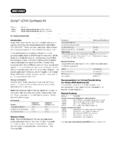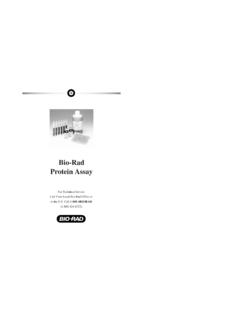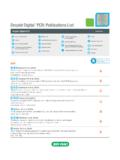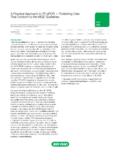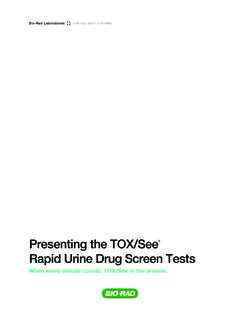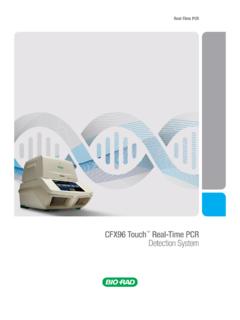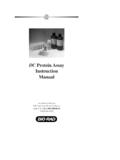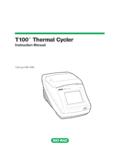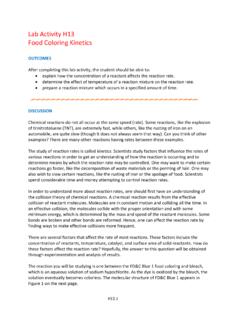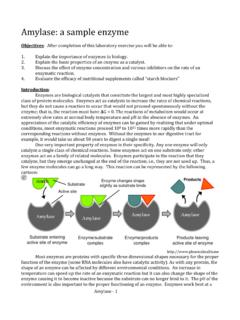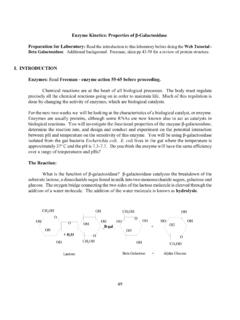Transcription of Quick Guide - Bio-Rad Laboratories
1 Quick GuideActivity 1: Determine the ReactionRate in the Presence or Absenceof an Enzyme1. Find your 15 ml conical tubes labeled Stop Solution , mM Substrate , Enzyme and Buffer . Write your initialson each Label five cuvettes E1 Label the two remaining cuvettes Start and End . 4. Using a clean DPTP, pipet 500 l of stopsolution into each labeled cuvette. Rinsethe DPTP well with Label one empty 15 ml conical tube Enzyme Reaction and the other Control .6. Using a clean DPTP, pipet 2 ml of mMsubstrate into the 15 ml conical tubelabeled Enzyme Reaction . Use thesame DPTP and pipet 1 ml of mMsubstrate into the conical tube labeled Control . Rinse the DPTP well Label one DPTP E for enzyme and theother C for control. Only use the DPTP labeled E for the enzyme reaction tubeand the DPTP labeled C for the controlreaction GuideQUICK GUIDEL abel up hereStop mM SubstrateControlEnzyme reactionStartEndE1E2E3E4E5 Read and understand steps 8 11 fullybefore proceeding.
2 These steps are timesensitive!8. Using the DPTP labeled C , pipet 500 lof buffer into the 15 ml conical tubelabeled Control and gently mix. Onceyou have mixed the buffer with the substrate, remove 500 l of this solutionand add it to your cuvette labeled Start .9. Using the DPTP labeled E , pipet 1 ml ofenzyme into the 15 ml conical tubelabeled Enzyme Reaction . Gently mix,then START YOUR TIMER. 10. At the times indicated, use the DPTP labeled E to remove 500 l of the solution from the Enzyme Reaction tube and add it to the appropriatelylabeled cuvette containing the stop After all the enzyme samples have beencollected, use the DPTP labeled C toremove 500 l of the solution from the Control reaction tube and add it to thecuvette labeled End .12. Proceed with the analysis of your samples. After you have finished youranalysis, rinse out your reaction (conical)tubes, cuvettes, and DPTPs with copiouswater and save them for later : Do not discard unused stock will be used for the next GuideQUICK GUIDEE nzymereactionE1 1 minE2 2 minE3 4 minE4 6 minE5 8 minControlEnd8 minBufferControlEnzymeEnzyme reactionControlStartQuick GuideActivity 2: Determine the Effect ofTemperature on the Reaction Rate1.
3 Label your cuvettes 0 C , 22 C , and 37 C . 2. Using a clean DPTP, pipet 500 l of stopsolution into each cuvette. Wash theDPTP out thoroughly with Label three ml microcentrifuge tubes 0 C Enzyme , 22 C Enzyme , and 37 C Enzyme . Using a clean DPTP,pipet 250 l of enzyme into each microcentrifuge tube. Rinse out theDPTP thoroughly with Label three ml microcentrifuge tubes 0 C Substrate , 22 C Substrate , and 37 C Substrate . Using a clean DPTP,pipet 500 l of mM substrate intoeach microcentrifuge tube. Rinse out theDPTP thoroughly with Place the tubes labeled 0 C Enzyme and 0 C Substrate in the ice cup. Placethe tubes labeled 22 C Enzyme and 22 C Substrate on your lab the tubes labeled 37 C Enzyme and 37 C Substrate in the beaker ofwarm water at 37 C. Allow the tubes toequilibrate to their respective tempera-tures for at least 5 GUIDEQ uick GuideLabel up hereStop Solution0 C22 C37 CEnzyme0 CEnzyme22 CEnzyme37 mM Substrate0 CSubstrate0 CSubstrate22 CSubstrate37 CSubstrate0 CEnzyme0 C22 CEnzymeRoomTemperature37 CEnzyme37 C22 CSubstrate37 CSubstrate6.
4 Have a stopwatch ready. Using a cleanDPTP, pipet the 250 l of enzyme fromthe tube labeled 0 C Enzyme into thetube labeled 0 C Substrate , and placethe tube now containing your enzymeand substrate mix back on ice. Add the22 C enzyme to the 22 C substrate solution, and place that tube back on thelab bench. Add the 37 C substrate to the37 C enzyme solutions, and put that tubeback into the 37 C water bath. STARTYOUR After 2 minutes, use a clean DPTP foreach temperature reaction to transfer500 l of your reaction to the appropriatelylabeled cuvette containing the stop solution. 8. Proceed with the analysis of your samples. After you have finished youranalysis, rinse out the cuvettes andDPTPs with copious water and savethem for later : Do not discard unused stock will be used for the next GuideQUICK GUIDE0 C0 C S22 C S37 C S0 C E0 C22 C ERoomTemperature37 C E37 C0 CS+E22 C22 CS+E37 C37 CS+E2 minQuick GuideActivity 3: Determine the effect ofpH on the Reaction Rate1.
5 Label your cuvettes pH , pH ,and pH . 2. Using a clean DPTP, pipet 500 l of stopsolution into each cuvette. Wash theDPTP out thoroughly with Using a clean DPTP, pipet 250 l of mM substrate into each microcentrifugetube labeled pH , pH and by your instructor. Wash the DPTPout thoroughly with Have a stopwatch ready. Using a cleanDPTP, add 250 l of enzyme to each ofthe labeled microcentrifuge YOUR After 2 minutes, using a clean DPTP foreach pH reaction, transfer 500 l of yourreaction to the appropriately labeledcuvette containing the stop solution. 6. Proceed with the analysis of your you have finished your analysis,rinse out the cuvettes and DPTPs withcopious water and save them for : Do not discard unused stock will be used for the next GUIDEQ uick GuideLabel up hereStop SolutionpH mM substrateEnzymepH minQuick GuideActivity 4: Determine the Effect ofEnzyme Concentration on theReaction Rate1.
6 Label one 15 ml conical tube LowConcentration Enzyme . Using a cleanDPTP, pipet 1 ml of buffer into the out the DPTP with water. Pipet 1 ml of high concentration enzyme toyour tube labeled Low ConcentrationEnzyme and mix. Wash out the DPTP thoroughly with Label three cuvettes H1 H3 (for highenzyme concentration time points) andthe remaining three cuvettes L1 L3 (forlow enzyme concentration time points).Only label on the upper part of thecuvette Using a clean DPTP, pipet 500 l of stopsolution into each cuvette. Wash out theDPTP thoroughly with Label one clean DPTP with an H forhigh enzyme concentration and a secondclean DPTP with an L for low GUIDEQ uick GuideLabel up hereBufferLowconcentrationenzymeHighconc entrationenzymeStop SolutionH1H2H3L1L2L3 Please read steps 5 7 fully before proceeding. These steps are time sensitive!
7 5. Using the DPTP labeled with an H ,pipet 250 l of mM substrate intoyour 15 ml conical tube containingenzyme labeled High ConcentrationEnzyme . 6. Using the DPTP labeled with an L , pipet250 l of mM substrate into your 15 ml conical tube containing enzymelabeled Low Concentration Enzyme .START YOUR TIMER. 7. At the times indicated, use the correctlylabeled DPTP to remove 500 l from the15 ml conical tubes labeled HighConcentration Enzyme and LowConcentration Enzyme , and add it to theappropriately labeled cuvette that alreadycontains the stop Proceed with the analysis of your samples. After you have finished youranalysis, rinse out reaction tubes,cuvettes, and DPTPs with copious waterand save them for later : Do not discard unused stock will be used for the next GUIDEQ uick mM SubstrateHigh concentration mM SubstrateLow concentration enzymeHigh concentrationenzymeH11 minH22 minH38 minLow concentrationenzymeL11 minL22 minL38 minQuick GuideActivity 5: Determine the Effect ofSubstrate Concentration on theReaction Rate1.
8 Label one clean 15 ml conical tube LowConcentration Substrate and one clean15 ml conical tube High ConcentrationSubstrate .2. Using a clean DPTP, pipet ml of mMsubstrate into the 15 ml conical tubelabeled High Concentration Substrate .Rinse the DPTP thoroughly with Using a clean DPTP, pipet ml ofbuffer into the 15 ml conical tube labeled Low Concentration Substrate . Rinsethe DPTP thoroughly with water and thenpipet 250 l of mM substrate into the15 ml conical tube labeled LowConcentration Substrate and mix. Rinsethe DPTP thoroughly with Label your cuvettes H1 H3 (for highsubstrate concentration time points) and L1 L3 (for low substrate concentrationtime points). Only label on the upper partof the cuvette Using a clean DPTP, pipet 500 l of stopsolution into each cuvette. Rinse theDPTP thoroughly with Label one DPTP as H for high substrateconcentration and a second DPTP as L for low substrate GUIDEQ uick mM SubstrateHigh concentration mM SubstrateLowconcentrationsubstrateLabel up hereStop SolutionH1H2H3L1L2L3 Please read and understand steps 7 9fully before proceeding.
9 These steps aretime sensitive!7. Using a clean DPTP, pipet 750 l ofenzyme into your 15 ml conical tube ofsubstrate labeled High ConcentrationSubstrate . 8. Using a clean DPTP, pipet 750 l ofenzyme into your 15 ml conical tube ofsubstrate labeled Low ConcentrationSubstrate . START YOUR TIMER. 9. At the times indicated, use the correctlylabeled DPTP to remove 500 l from the15 ml centrifuge reaction tubes labeled High Concentration Substrate and LowConcentration Substrate and add it tothe appropriately labeled cuvette thatcontains the stop Proceed with the analysis of your samples. After you have finished youranalysis, rinse out the reaction tubes,cuvettes, and DPTPs with copious waterand save them for later : Do not discard unused stock will be used for the next GUIDEQ uick GuideEnzymeHigh concentration substrateEnzymeLow concentration substrateHigh concentrationsubstrate reactionH11 minH22 minH38 minLow concentrationsubstrate reactionL11 minL22 minL38 minQuick GuideActivity 6: Test the Ability ofMushroom Extracts to Increasethe Reaction Rate1.
10 Write down the name of your mushroom_____2. Weigh out approximately 1 gram ofmushroom and put it into a Add 2 ml of extraction buffer for everygram of mushroom into the mortar. Tocalculate the amount of extraction bufferyou need, multiply the weight (in grams)of the mushroom by 2 and add that manymilliliters. Weight of mushroom ____ g x 2 = _____ ml4. Using a pestle, grind your mushroom toproduce a Strain the solid particles out of your slurryusing a piece of filter paper or cheesecloth into a ml microcentrifuge , if you have a centrifuge,scoop the slurry into a ml microcentrifuge tube and then pellet thesolid particles by spinning at top speedfor 2 minutes. Note: You will need atleast 250 l of extract to perform theenzymatic Label your cuvettes 1 6 . Only label onthe upper part of the cuvette GUIDEQ uick GuideExtraction bufferLabel up here7.
